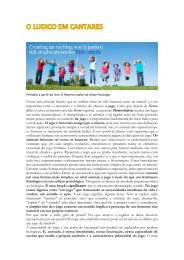Motherhood in Childhood
Create successful ePaper yourself
Turn your PDF publications into a flip-book with our unique Google optimized e-Paper software.
suggest that between 38 per cent and 68 per cent<br />
of women treated for complications of abortion<br />
are below 20 years of age.” In Ethiopia, <strong>in</strong><br />
2008, “an estimated 52,600 women received care<br />
<strong>in</strong> a health facility for complications of unsafe<br />
abortion” (Guttmacher Institute, 2010). Given<br />
that women seek<strong>in</strong>g abortion <strong>in</strong> Ethiopia have a<br />
mean age of 23, it is safe to say that a significant<br />
proportion of those treated for abortion complications<br />
<strong>in</strong> Ethiopia are adolescents (Guttmacher<br />
Institute, 2010). A recent paper (Abdella et<br />
al., 2013) estimated that the direct cost to the<br />
national health system <strong>in</strong> Ethiopia for treat<strong>in</strong>g<br />
post-abortion complications was between $6.5<br />
million and $8.9 million per year. In some countries<br />
<strong>in</strong> Lat<strong>in</strong> America, hospitals are crowded with<br />
adolescents need<strong>in</strong>g treatment for complications<br />
from pregnancy, childbirth, or abortion.<br />
The costs are not limited to abortion complications<br />
nor are they limited to develop<strong>in</strong>g<br />
countries: “In 2008 [<strong>in</strong> the United States], teen<br />
pregnancy and childbirth accounted for nearly<br />
$11 billion per year <strong>in</strong> costs to United States taxpayers<br />
for <strong>in</strong>creased health care and foster care,<br />
<strong>in</strong>creased <strong>in</strong>carceration rates among children of<br />
teen parents and lost tax revenue because of lower<br />
educational atta<strong>in</strong>ment and <strong>in</strong>come among teen<br />
mothers” (National Campaign to Prevent Teen<br />
and Unplanned Pregnancy, 2011).<br />
Conclusion<br />
Adolescent pregnancy and childbirth can have<br />
negative consequences for girls’ physical and<br />
mental health and social well-be<strong>in</strong>g, their educational<br />
atta<strong>in</strong>ment, and their <strong>in</strong>come-earn<strong>in</strong>g<br />
potential. These impacts are rooted largely <strong>in</strong><br />
persistent gender <strong>in</strong>equality and discrim<strong>in</strong>ation<br />
<strong>in</strong> legal, social and economic structures,<br />
which result <strong>in</strong> stigma and marg<strong>in</strong>alization and<br />
“It is taboo to talk about sex. Sometimes,<br />
there are programmes about contraception<br />
on TV but young people do not pay<br />
enough attention. We discuss sex among<br />
ourselves, but we do not address the issue<br />
with our parents. Most often, it is the<br />
girls who ask the boys to use condoms.<br />
The boys do not th<strong>in</strong>k to ask the girls<br />
to take the pill or another method of<br />
contraception.”<br />
Ngimana, 17, Senegal<br />
violate fundamental human rights. When girls<br />
are denied the <strong>in</strong>formation and services they<br />
need to prevent pregnancy, their autonomy is<br />
underm<strong>in</strong>ed. When they become pregnant and<br />
are forced from school, their rights are violated.<br />
When they are forced to marry or are subjected<br />
to sexual violence or coercion, their rights are<br />
additionally violated.<br />
When their human rights are respected, girls<br />
are less likely to be stigmatized and marg<strong>in</strong>alized<br />
and are free to develop and ma<strong>in</strong>ta<strong>in</strong> healthy<br />
relationships with friends and peers. They have<br />
access to sexual and reproductive health services<br />
and are able to get an education, regardless of<br />
their situation. They are better able to become<br />
healthy, productive and empowered citizens<br />
who can participate as equal members of their<br />
households, communities and nations.<br />
THE STATE OF WORLD POPULATION 2013<br />
29

















